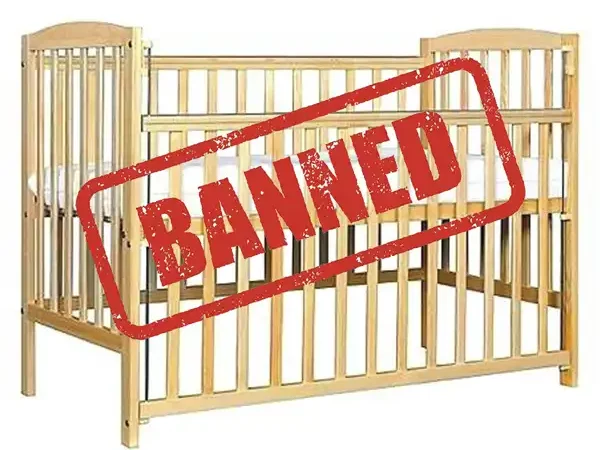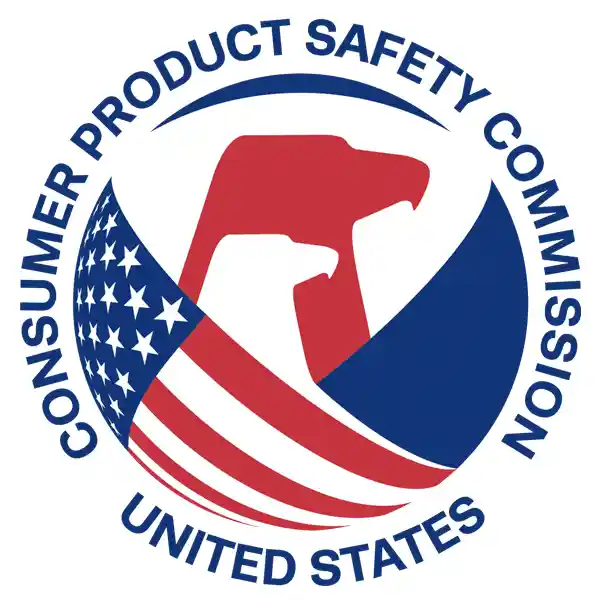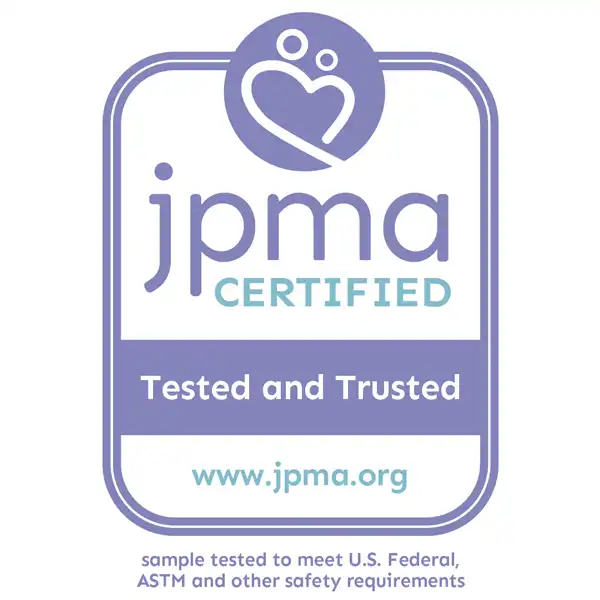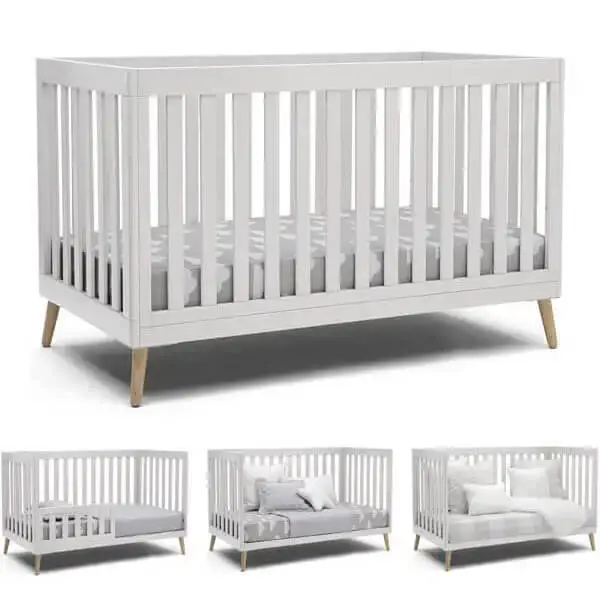
A crib is where babies spend most of their unsupervised time, making safety a top priority. So, choosing a crib that meets current baby crib safety standards is essential.
But buying a crib that meets federal crib safety standards is just the first step. To create a truly secure sleep environment, you must also set it up correctly, use it properly, and pair it with a firm, well-fitting mattress. It’s also important to follow baby-safe sleep guidelines—they matter just as much as crib safety standards. (We’ve included a link to safe sleep practices later in the article.)
Feeling overwhelmed? Don’t worry—this article includes everything you need to know to keep your baby safe in their crib. First, we’ll go over the latest CPSC crib safety standards. Then, we’ll dive into additional steps you can take to ensure a safe and restful sleep for your little one.
CPSC Baby Crib Safety Standards
The most recent baby crib safety standards in the U.S. were established by the Consumer Product Safety Commission (CPSC). These standards went into effect on June 28, 2011, and remain in place today.
Since that date, all cribs sold in the U.S. must comply with these safety regulations.
It is illegal to sell cribs that fail to meet even one of the safety specifications outlined in the new federal crib safety standards! (Note: Childcare centers, hotels, and other public facilities are also required to use only cribs that meet new crib safety standards.)
For the full details on official CPSC crib safety standards, you can refer to the following links:
- 16 CFR Part 1219 – Standards for full-size cribs.
- 16 CFR Part 1220 – Standards for non-full-size cribs (such as mini cribs and portable cribs).
But if you’re looking for a simpler breakdown, we’ve summarized the key CPSC crib safety standards below.
Current Baby Crib Safety Standards in the U.S.
The latest baby crib safety standards focus on stronger materials, safer designs, and stricter testing requirements to ensure cribs provide a secure sleep environment.
If you’re looking for a crib that meets all baby crib safety standards while being sturdy, stylish, and affordable, the Delta Children Essex 4-in-1 Convertible Baby Crib is a great choice. It follows all CPSC, ASTM, and JPMA safety regulations, features a strong frame, and grows with your child. Check it out here ? Delta Children Essex convertible baby crib.
Here’s a breakdown of the key regulations every parent should know:

Who set crib safety standards and guidelines?
As mentioned earlier, the Consumer Product Safety Commission (CPSC) is responsible for establishing crib safety standards in the U.S. However, developing these regulations is a collaborative effort involving several key organizations dedicated to crib safety.
Two of the most influential contributors are ASTM International (formerly the American Society for Testing and Materials) and the Juvenile Products Manufacturers Association (JPMA).
CPSC

CPSC (Consumer Product Safety Commission) – An independent U.S. government agency that develops and enforces product safety regulations. The CPSC works to reduce the risk of injury by conducting research and establishing safety standards for consumer products, including cribs.
JPMA

JPMA (Juvenile Products Manufacturers Association) – This organization provides voluntary third-party certification to verify that cribs meet CPSC and ASTM standards. While JPMA certification is a valuable indicator of safety, it is not legally required.
ASTM

ASTM International (American Society for Testing and Materials) – A global organization that develops voluntary technical standards for materials, products, and systems. ASTM sets additional crib safety guidelines that manufacturers follow to ensure durability, performance, and safety.
Is GREENGUARD Gold Certification part of safety standards?
No, GREENGUARD Gold certification is not a required crib safety standard like CPSC, ASTM, or JPMA certification. However, it’s a great bonus for parents who are concerned about indoor air quality.
What Does GREENGUARD Gold Certification Mean for a Crib?

If a crib is GREENGUARD Gold certified, it has been tested for over 10,000 chemicals and volatile organic compounds (VOCs) to ensure low emissions. This helps reduce your baby’s exposure to potentially harmful toxins like formaldehyde, phthalates, and flame retardants, which can sometimes be found in crib finishes and materials.
Are Used Cribs Safe?
Safety Requirements You Need to Know
Thinking about using a second-hand crib? While a new crib is typically the safest and most reliable choice, a well-maintained hand-me-down can also be a good option—as long as it meets current safety standards.
Before using an older crib, it’s important to check whether it complies with new federal crib safety standards and is still sturdy and secure.
To make this easier, I’ve put together a step-by-step checklist to help you determine if your crib is safe and up to date with CPSC regulations.
Second-hand Crib Safety Checklist:
1. Check the Crib’s Manufacture Date
Look for a label or sticker with the manufacture date. It is usually located on the crib’s frame. Do not use a crib made before June 2011, as it may not reach current baby crib safety standards!
If the crib has a drop-side rail, you don’t even need to check the date—it’s not safe! Drop-side cribs were banned in June 2011 and can no longer be sold.
2. Verify Recalls
Make sure the crib hasn’t been recalled for safety issues. You can check this by visiting the CPSC recall database and searching for the crib’s brand and model number.
Unfortunately, sometimes, an issue occurs when the crib is already in use. The manufacturer is required to recall an unsafe crib, notify customers, and work with the CPSC to list it in the recall database. If the old crib has been recalled, do not use it, even if it looks safe.
3. Inspect for Damage or Weakness
If the crib isn’t too old and hasn’t been recalled, your next step is a thorough inspection.
- Look for signs of excessive wear. If the crib has been assembled and disassembled multiple times (convertible cribs), parts may be weakened or stripped, making the crib less stable.
- Gently shake the crib to check for wobbling or instability.
- Inspect for cracks, splits, or weak spots in the wood or joints.
- Small scratches and minor dents are okay, but broken parts are not safe! Replace damaged parts with original manufacturer parts, or do not use the crib. Do not modify the crib with third-party parts!
4. Make Sure All Crib’s Hardware is Present and Secure
Check that all hardware is intact—there should be no rusted, missing, loose, or damaged screws, bolts, or brackets. Everything should be tight and secure without needing constant re-tightening.
5. Check the Crib Mattress and Support
If the crib comes with a used mattress, consider replacing it to prevent risks from mold, dust mites, or indentations that could pose a suffocation hazard.
To check the mattress support, press down on it. It should not sag—it must remain firm and supportive.
Additional Baby Crib Safety Guidelines
Ensuring your baby’s crib meets CPSC safety standards is a great start, but there’s more you can do to create a truly safe sleep space.
Safety guidelines to follow at home:
1. Assemble the Crib Correctly
Carefully follow the manufacturer’s instructions during assembly. Missing screws or loose parts can make the crib unstable. Regularly check and tighten all hardware to keep it secure.
2. Choose a Safe Mattress
A firm, well-fitting mattress is essential. Make sure there are no gaps larger than two fingers between the mattress and crib frame. Use only a fitted crib sheet—no loose bedding, pillows, or bumpers.
3. Find the Best Crib Placement
Keep the crib away from windows, blinds, and cords to prevent strangulation hazards. Avoid placing it near furniture your baby could climb on or under air vents that could cause temperature fluctuations.
4. Perform Routine Safety Checks
Inspect the crib regularly for loose or broken parts. If your baby starts pulling up, lower the mattress to prevent climbing out. Once they can consistently climb over the rails, it’s time for a toddler bed.
5. Follow Safe Sleep Practices
Always place your baby on their back to sleep. Keep the crib free of toys, blankets, and bumpers to reduce the risk of Sudden Infant Death Syndrome (SIDS).
Want more details? Check out our full guides on keeping your crib safe at home and safe sleep practices for babies to ensure your little one’s crib remains a secure place for restful sleep.
The Bottom Line
A crib is where your baby spends most of their unsupervised time, so safety is a must. Choosing a crib that meets current baby crib safety standards is only the first step. To create a secure sleep environment, you also need to set it up correctly, use a firm, well-fitting mattress, and follow safe sleep guidelines. The CPSC crib safety standards ensure cribs are structurally sound, with banned drop-side rails, stronger slats, and non-toxic finishes. Whether you’re buying new or considering a second-hand crib, always check that it meets the latest safety requirements.
Crib Safety Checklist
By following these guidelines, you can ensure a safe and restful sleep for your little one.


My daughter is having her first baby, and she is insisting on some sort of bed that’s basically on the floor, with no sides. I’ve never seen anything like that and I feel it’s extremely unsafe. But she refuses to listen and says she’s done her research. Any thoughts on this?
Hello Monica!
I assume your daughter is considering buying a Montessori Floor Bed. I think such a bed is by no means suitable for newborns and young babies!
OK, assuming the newborn can’t roll over yet, so there is no danger of her falling out of such a bed…. I know your daughter wants only the best for her baby, but she forgot about herself. She will have to lift the baby numerous times during the night (feeding, changing nappies, snuggling, etc.). Her back will suffer a lot, especially in the first months after giving birth. Is she willing to take a risk?
Proponents of this method also claim that crib slats block the baby’s view of the surroundings so that babies can’t observe the environment. First of all, crib slats are apart enough to be safe for the baby while not blocking her view. And second, infants can’t see far yet. Their vision is still developing, so such claims are pointless to me.
The next thing I am skeptical about is staying on the bed. Those who advocate such sleep argue that a baby won’t hurt herself by falling out of bed. OK, assuming that this is true … your daughter needs to prepare to find her baby (and later toddler) sleeping on the floor many times. Crib’s rails and toddler bed safety guardrails are there for a reason!
The original purpose of floor beds is giving the baby freedom. Floor beds are not raised off the floor so that the baby can get in and out once she starts crawling. Older babies can wake up and crawl throughout the nursery to occupy themselves, but they will do that even in the middle of the night.
Your daughter will have to establish a solid bed routine only to hope to sleep through the night when her baby starts crawling. When the baby begins playing once, she wakes up completely! Falling back asleep will be so much harder!
But the thing that worries me the most is how to ensure safety in the whole nursery. Well, in the entire home, if the door of the nursery is not ALWAYS closed! Meaning, all furniture bolted to the wall, no reachable curtain cords, no rechargeable cords, covered outlets, no reachable curtains, locked windows, etc.
I am sure every parent’s priority is to child-proof their homes. However, babies can get out of floor beds freely, including in the middle of the night. Is your daughter sure she will always wake up? Therefore, she must take child-proofing to a higher level.
She must inspect the entire home making sure there is no dangerous object on the floor or within baby’s reach. And she should do that every night before bed! No forgotten objects that pose a potential risk shouldn’t be left on the floor. Objects that could be tipped over by the baby, must be removed, etc.
I mean, why so many extra worries if you can decide on a crib, bassinet, or portable crib? American Academy of Pediatrics states: “A crib, bassinet, portable crib, or play yard that conforms to the safety standards of the Consumer Product Safety Commission (CPSC), including those for slat spacing less than 2-3/8 inches, snugly fitting, and firm mattresses, and no drop sides, is recommended.”
Personally, I find floor beds cute, but I would only start using such a bed with a toddler.
Regards, Ines!
is a stain and finish with a 250 voc ok for a baby cradle
We think that 250-VOC stain and finish is not a good choice for finishing a baby’s crib.
The best and the safest way is to buy a GREENGUARD Gold-certified crib, which has been tested by a third party to be safe for your baby. But, while it is best to avoid painting the baby crib, there are ways you can do it safely.
If you are planning to paint your nursery furniture, we suggest you invest in no-VOC paint. These are Zero-VOC paints and natural paints.
At this point, I have to mention Low-VOC paints too. While some consider they are safe, others think their emissions are higher than they should be. Low-VOC paints have a reduced amount of VOCs, but their label “low,” may be only a comparison to some other colors.
Low-VOC paints usually contain 50g/L or less VOC, but no standard defines what “low” means, so read the label carefully. So, to use in the nursery make sure it contains less than 50g/L VOCs.
Natural paints and Zero-VOC paints have no or less than 5g/L volatile organic compounds in them. So to be safe, check up on the label to ensure your paint contain no additional solvents or additives and check for 5g/L or less of VOCs.
Regards, Baby’s Little Place
Does the crib have to have both, Greenguard and JPMA certificate to meet all the baby crib safety standards?
I love your crib reviews because you captured everything parents should know before they decide for a certain crib.
After reading Hudson crib by Babyletto review, I think I am pretty much certain which one I will pick for my Baby. Tnx
No, it needs one of those two certificates to meet baby cribs safety standards, because they both mean the same. If the crib is JPMA or GREENGUARD Gold certified it has no toxic chemicals or toxic paint. The manufacturer picks an independent facility that will test their products, some decide for JPMA, other for a GREENGUARD certificate. If they get it of course. ?
We always try to capture everything in our reviews, so I am glad we helped you with your decision! Babyletto Hudson 3-in-1 convertible crib is a good choice! Wish you lots of joy with your baby!